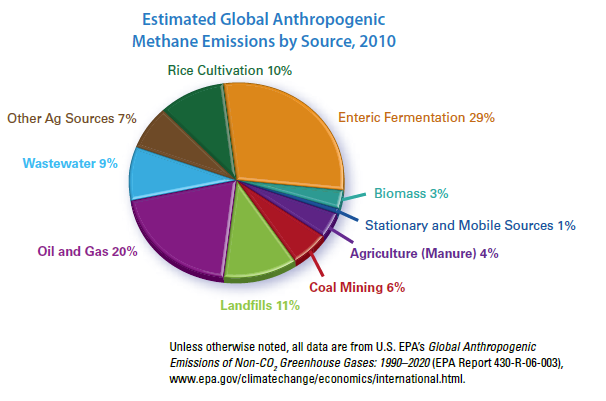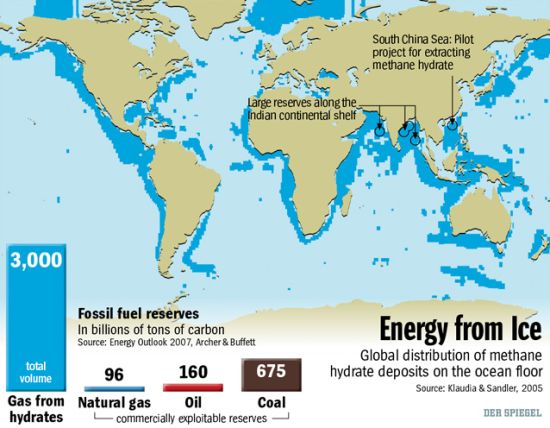Published at The Energy Collective, Dec. 3, 2013
There has been a lot of talk this week about a new PNAS study which found much higher levels of methane in the atmosphere than previously estimated. Reactions to the study were predictable. Climate activists sounded the alarm and reiterated their position that natural gas is no solution for clean energy because systemic leakages of methane outweigh any benefits. The gas industry response was that the data was old since it was from 2007-08 and they have been working to reduce their emissions since then. My reaction was that this study was one more piece of evidence that there is a lot of methane out there available to be captured and utilized, it is one of the most common molecules in the universe after all.
There are many sides to the methane story. One side is that methane is a potent greenhouse gas whose concentrations in the atmosphere closely track temperatures, and have been rising steadily since the industrial revolution began. Another side of the story is that methane is a non-toxic replacement to coal and oil found in voluminous quantities throughout the world. Fortunately, by dealing with the leakage problem we enhance the efficacy of the clean fuel solution. It is a win-win to capture as much methane as possible to keep it out of the atmosphere and use it instead as clean fuel.
The Global Methane Initiative is an international consortium focused on developing practical technical solutions for capturing methane emissions. They have five main areas of focus: Oil and Gas Systems, Landfills, Wastewater, Coal Mines and Manure Management. For each of these industries there are proven techniques to capture methane emissions, but the challenges tend to be economic. Without mandates or other incentives, the value of the captured gas is generally not competitive with current low natural gas market prices.
For example, dairy farms in the USA produce methane from animal waste and the farmers are well aware of the potential for anaerobic digestion to provide multiple benefits; odor reductions, improved fertilizers and home brewed fuels. Unfortunately though, these solutions are rarely implemented because small farmers lack the necessary capital to purchase the equipment and have little economic incentive to do so. There is no government support or mandates to install the digesters, the biogas that is produced does not work for their diesel tractors and producing electricity is hardly worth the effort since electricity is cheap. Upgrading biogas to pipeline quality methane is easy technically but the capital costs for the equipment and pipeline expansions are daunting. The main benefit in lieu of any clean energy or pollution regulations is odor control, which is certainly nice but hardly central to the economics of the farm.
Landfills often have mandates to capture methane and this is the leading source of biomethane being marketed today. So much more could be done through aggressive zero waste strategies that bypassed landfills altogether and processed all food and carbonaceous wastes into clean fuels. Coal bed methane has emerged as an important source of natural gas and a possible bridge to the future for coal regions. Sewage treatment offers another source for local gas production that could be supplemented if food wastes were to be sent down the drains via in-sink disposals. A report produced by the Gas Technologies Institute (GTI) concluded conservatively that 10-20% or more of current natural gas demand could be met by renewables; biomass, sewage, garbage and manure.
The oil and gas industry is well aware of the public pressure to reduce methane emissions. They have been moving towards “green completions” and other solutions to reduced leakage in pipes. Well-designed regulations will be needed to enforce this effort. But an unfortunate consequence of low gas prices is that producers of other fossil fuels can afford to waste natural gas in order to get at higher priced liquid fuels. The Bakken Shale in North Dakota has become infamous for the amounts of methane being flared while oil is produced. The Canadian tar sands offer a similar dynamic, huge quantities of natural gas are consumed to produce the bitumen from the ground.
Clean air regulations have been very effective at reducing criteria pollutants such as sulfur and particulates, improving air quality and saving lives. If these mandates continue to be ratcheted down the market will steadily be pushed towards natural gas, since methane contains no toxic contaminants. This trend towards gas has been clear in the electric power industry where the combination of pollution controls and low gas prices has pushed the conversion from coal to gas. We are also seeing this trend take form in the marine fuels market where dirty bunker fuel for ships is being forced out of the market by new USA\Euro emissions standards. Ship operators are required to install expensive exhaust scrubbers if they want to continue using dirty fuels or else switch to LNG (low sulfur diesel has been too expensive).
Methane capture is very important for the environment and local economies, but the quantities are not substantial relative to the overall market for fossil fuels. Shale gas has been the big player lately that has impacted the markets, but the potential for the methane hydrates makes shale gas look like hors d’oeurvres. Methane hydrates (also known as clathrates) are concentrates of methane encased in ice found in the ocean floor along the continental shelves throughout the world. They have yet to be commercially produced but there is serious work being done to bring these resources to market. The Japanese, Chinese and Indians are particularly keen to develop the resources as they have the greatest unmet needs for new energy supplies. Just as shale gas was unlocked through the efforts of one ambitious engineer, George Mitchell, we are one engineering breakthrough away from repeating the trick on a much bigger scale with methane hydrates.
This graphic from German newspaper Der Spiegel presents a view of methane hydrate availability and illuminates some of the major implications. First of all, the reserves are massive, dwarfing all know coal and oil deposits. 3000 Gigatons is even a conservative estimate, some analysts have modeled over 60,000 Gt. Secondly they are spread relatively evenly throughout the world reducing potential conflicts between nations.
Climate activists tend to be horrified at the mention of developing the methane hydrates. It is thought that burning this much carbon would surely send the climate over the edge. The Clathrate-Gun Hypothesis suggests that rising temperatures may release frozen methane and trigger rapid runaway climate change and may have been the cause of mass extinctions in the past. Another danger in mining the hydrates is the potential to destabilize the sea floor and trigger tsunamis.
The positive potential for the hydrates should be viewed in terms of replacing dirty coal and oil. Methane hydrates could be produced close to coastal cities, with no messy drilling on land and no oil to spill. Off shore mining combined with floating LNG production would enable container ships to be loaded with LNG on the spot for global distribution bypassing the crude oil trade. If gas can be produced cheap enough to compete with oil and pollution standards are enforced then the markets will naturally shift to natural gas. To truly displace coal and oil we need the volume of product at the right prices to make dirty fuels unnecessary and methane hydrates just might be able to fill the bill.
As the old expression goes, “the stone age did not end for lack of stones”. Nuclear has an important role to play in providing bulk heat and power, but hydrocarbons are still needed in the mix because they perform critical roles in providing storable fuels, chemicals, plastics, fertilizers and backing up renewables. Rather than trying to eliminate hydrocarbon fuels, we should be focusing on producing them cleanly and using them efficiently.

